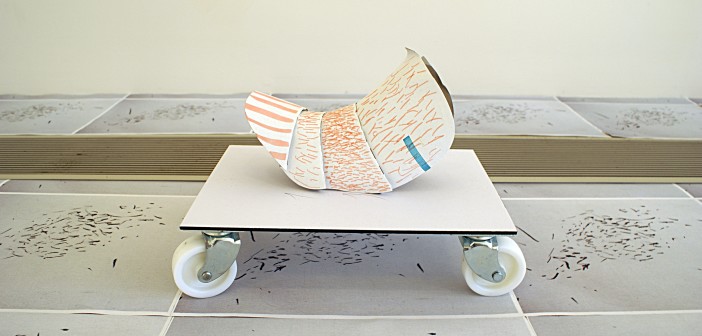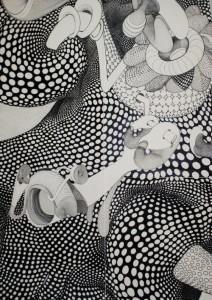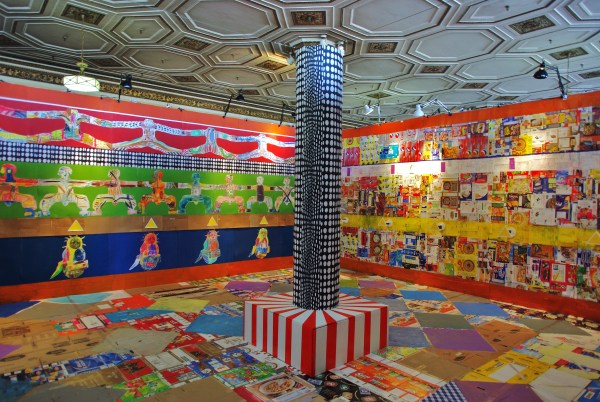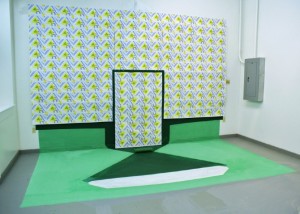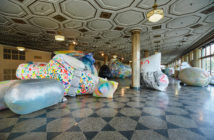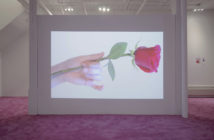Boston is a transient city. Each fall, legions of artists enroll in graduate programs throughout the city to nurture their talents and connections, and approximately two years later, many move on. While they are here, some of these artists are presented via exhibition or editorial to the city, and many inform and evolve the Boston art community. So why do so many leave? And how does the city affect their practice? In Elsewhere, we seek to reconnect with some of these former Boston artists, to discuss their reasons for leaving, and to see how their work subsequently progressed.
In this first installment, we speak with Natalia Afentoulidou. A 2012 graduate of Boston University, Afentoulidou came to Boston from her native Athens and quickly began assimilating the city into her process and practice. During her studies, Afentoulidou was selected for Cate Mcquaid’s annual “Young Artists to Watch” list and was included in the 2011 Boston Young Contemporaries exhibition. Earlier this year, BU’s Stone Gallery presented Strings and Rails Anyway, a solo show of her recent work. Afentoulidou now lives and works in San Diego, California.
Please describe your work before coming to Boston. Did you come to Boston directly from Athens? What initially attracted you to studying at Boston University?
Before coming to Boston my work was solely black and white, and my materials pen and pencil on paper.
For several years, I have been primarily interested in creating images that are built up by the motif of circles in all shapes and forms. The core of this interest was to focus on something basic and humble and elevate it in a bold, new meaning. The circle is an ideal form of drawing. By multiplying the circle and exploring all of its potential, I found pleasure in creating large-scale works. In an abstract way at first, and later in a more surrealistic, Op Art way.
After graduating from Athens School of Fine Arts, I applied to two universities for an MFA. I was accepted to both, but BU was my top choice. This was because I valued the focus on studio practice above all. My two years at BU were precious to me and my work, as I had hoped they would be. BU offered me space and time to work in a professional manner, which I thought was unique.
What was your initial impression of the city coming from Athens? Will you describe the community you found in Boston and the New England area?
I came from Athens to Boston in the fall of 2010, and a few days later, my first semester started. I felt like I was overwhelmed to be in a new city, with new people, every minute of each day. The contrast from the culture in Boston to the culture in Athens is undeniable. The heavy winter that seemed to happen immediately was difficult to face. The city was covered with snow almost all winter, which affected my work and how I felt in general. To adjust, my work was my lifeline, my studio was my shelter. It was the only place I could be free, careless, and open up through my work. Everything else was a matter of adaptation and mindfulness.
Despite the weather, Boston seemed to be a kind warm city. I was keen on the work ethic there, and the art scene felt vibrant. In the years following my graduation, I felt the gallery scene wasn’t as bold or creative as the many artists living in the city. But the museums are vibrant, the ICA, MFA, the Gardner and the impressive university museums. I felt energized by their collections and rotating exhibitions, which is essential to my creative practice.
What type of work did you make in grad school? Have you always worked with installation, and at a large scale? How did that differ from work you made before?
While in grad school my work evolved and changed dramatically, but I was consistent with the basic lines of my practice. The ideas and scale remained the same, but the material and subject matter changed. I was more than ever obsessed with the idea of creating something of significance by using something unimportant and humble. The material became a major vehicle to achieve that meaning: I started collecting my paper from paper discarded in trash bins. In order to fulfill my need for a large-scale piece, I had to find a source for a large amount of paper. Every Monday morning I would go through the blue recycle bins waiting to be collected in my neighborhood, gathering all the material I needed, literally and figuratively. For example, the recycled materials linked to my previous works, Circle Recycled, created years before.
Through that impulsive process, I created a big body of work that led to my thesis exhibition.
The installation part came from my need to use my work as my shield and portable home. Installation gave me the power to conceive and create what surrounds me, therefore connecting me to my actual surroundings that were all still so new to me. Although my previous works were 2D, they suggested a 3D realization. I needed now to place that work in space, making it surround me and my reality.
You were included in Boston Young Contemporaries and had several shows at BU while you were a student. Otherwise, did you feel supported by the local gallery scene here? Why or why not?
While a student, I took advantage of all the opportunities to show my work in shows at BU or ones that the University organized elsewhere. I was and still am so thankful of everything that I was able to do while in BU.
Soon after graduating I looked around for a supportive art community and I realized that it was hard to find in Boston. The commercial galleries in Boston are so few, especially considering the number of art institutions and young artists that graduate from them each year. A big downside of the city’s art scene is how close it is to New York. I felt that was a huge part of why things seemed to be somewhat limited and conventional. Some of my artist friends relocated in New York to take advantage of the energy and opportunities there. I visited New York frequently to keep updated.
But as much as young artists could blame Boston for its limitations in showcasing our art and supporting our careers more, I think that the city’s young artists should invest more in its potential, which in my opinion is truly great.
When and why did you leave Boston? How has your work evolved since leaving? What are you working on now?
I left Boston five months ago because my spouse had a unique job opportunity. I relocated to San Diego, which is a wonderful city with a lot of beauty and tempo. I am always eager and unafraid to allow my work to lead me to new places and new ways of creating. My move to San Diego hasn’t marked my work as drastically as relocations have influenced my work before. I continue to make some drawings and small objects out of found materials and to observe what surrounds and moves me.
San Diego is a very vibrant city and so different from Boston in so many ways. I cannot really evaluate the art community yet. I have to live, explore and engage more. But I am positive that my community will form based on how I establish myself and how I respond to the city’s offerings. I already have plenty of wishful ideas and projects that the city helps me envision. In a hopefully near future, I would love for myself to create work for open spaces, work that engages the viewer and ideally in a non-expecting environment. I wish to expand my work in a direction that is all the more filtered from an exogenous source. I am looking to create new perspectives and new work, more by listening, looking and communicating with what is around, rather than by what is already established in my consciousness.
I trust that my work is a better conveyance of anything I can write. But I also attest being conceptually committed to the idea of ritual and the attentiveness to the present and immediate surroundings.

